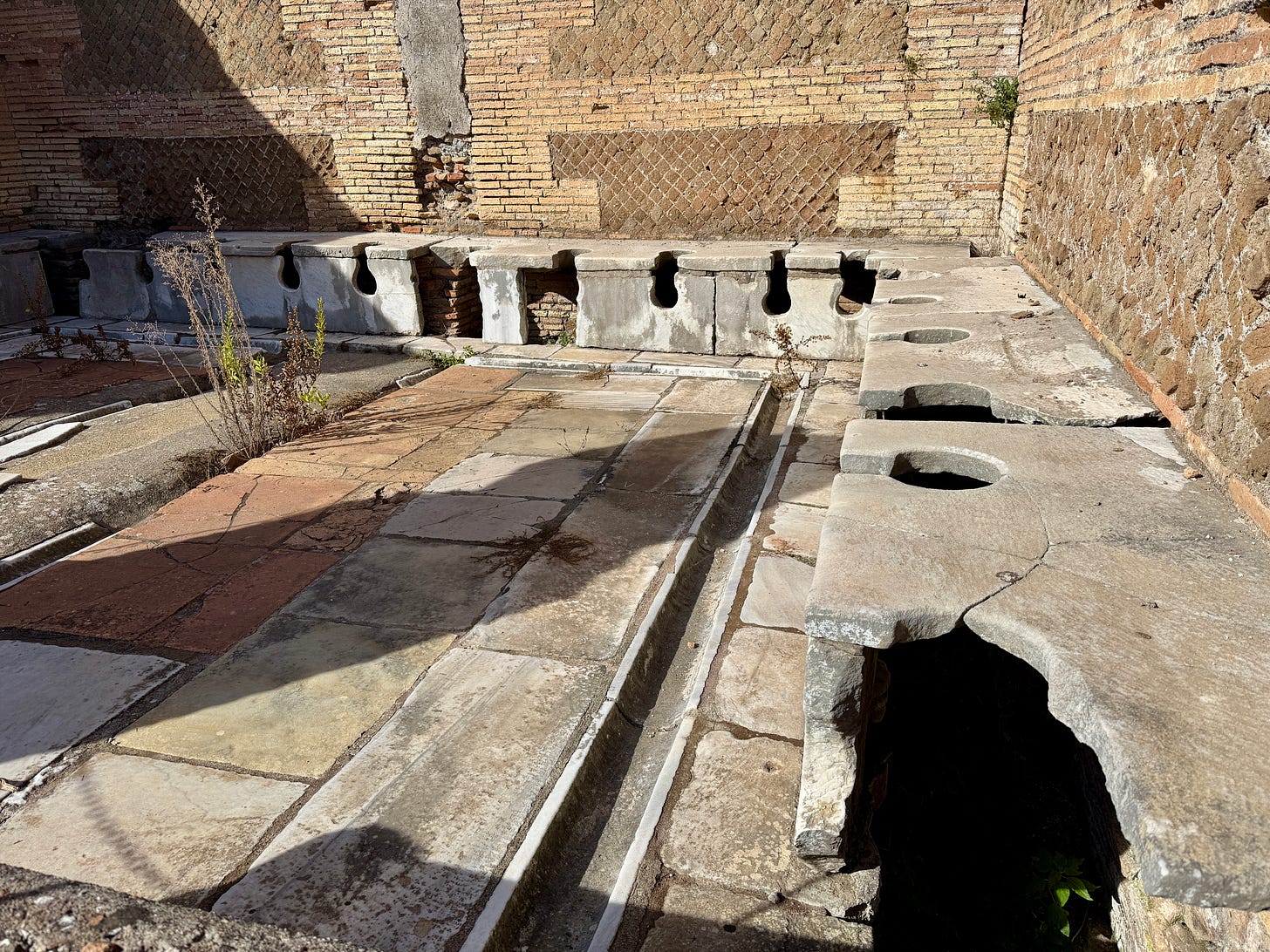I’m back from my research trip and have so many interesting things to share with you.
Before I tell you all about Ostia, here’s a reminder for my paid subscribers that Thursday November 13th is the next “Ask Me Anything about Italy.” It’s happening at 8:00 p.m. ET on Zoom, and if you can’t make it, please send me an email with your question. I’ll answer it live, and then you can watch the replay the following morning.
Then, on November 20th, I’ll be premiering the next Destination Deep Dive on Rome. I spent 5 days in Rome just to research this Deep Dive.
Here’s how it works. If you’re a paid subscriber, you’re invited to the live premiere on Zoom. It will be available to paid subscribers until I finalize the version, which will then be made available for sale along with a complete itinerary and bonus resources. And paid subscribers get a 50% discount.
Last Sunday, I was wandering around Ostia Antica, desperately searching for the restroom. Not the modern one, which was located right next to the entrance of the archaeological park, but the ancient one, where Romans would take care of their essential personal business sitting, uh… cheek to cheek.
The communal toilets are the most famous thing in Ostia, but they aren’t marked on the map or any of the signage. I knew they were part of the bath complex that was adjacent to the forum.
Today, the ancient city of Ostia is located near the airport, but 2,000 years ago, it was also an industrial hub where goods came in and out, due to its strategic position where the Tiber River meets the sea. The experience is similar to Pompeii, but Ostia wasn’t buried by a volcanic eruption; instead, it sank into the silt and turned into a swamp fiercely guarded by malaria-carrying mosquitoes until it was reclaimed in the 1940s.
Today, it’s a well-tended but little-visited archaeological site. It’s easy to reach from the center of Rome, and easier to traverse than Pompeii, with lots of spots to sit on ancient stone beneath lush umbrella pines that stretch their lush branches in all directions like they slept late and just got out of bed.
After winding my way through the Forum baths, the gym, the hot room, and the cold room, I found the famous toilets. The engineering is all exposed, including a channel where water would constantly flow to flush away waste. The openings in the marble bench where people sat are about as close to each other as the indents on the New York City subway.
Being shocked at the lack of privacy is not something most people, throughout most of human history, would have even noticed. Today we are awash in privacy and convenience that we take entirely for granted. And while the pleasures of indoor plumbing, kitchens, washing machines, and air conditioning eliminate much of the drudgery of life, these conveniences have fundamentally reshaped our society. The more privacy we enjoy, the less we need the public square and each other.
I always discourage people from taking a day trip to Pompeii in favor of a much easier trip to Ostia Antica. While yes, it’s possible to take the fast train, and there are lots of bus tours offering this, it’s a very long and expensive day of getting there and back for what is necessarily a swift and shallow experience of Pompeii, which deserves a good, long visit. Ostia Antica offers the same experience, allowing you to walk through a Roman city along the same roads as everyday citizens, past their homes, shops, and public buildings.
Also, it’s so peaceful.
Even though it’s extremely easy to get there, just $3.50 on the very pleasant Metromare train, only the most interested travelers go there, along with school groups, so you can take your time gazing at the mosaics of sea horses and the gods of the sea in what were the baths of Nerone. You can explore a thermopolium, a typical Roman quick-service restaurant, as only the wealthiest Romans had kitchens, and enslaved people to prepare meals for them at home. There’s a theater, a district of warehouses, as this was a port town where the work of shipping across the Roman Empire was done, and the oldest known synagogue in Europe. Just outside the archaeological park is a castle and a cobblestoned district of restaurants where you can eat very well. Or go one more stop on the train, or grab a quick taxi ride to be right on the beach and enjoy a perfect dish of spaghetti and clams for lunch.
Ostia Antica was diverse, like most Roman cities. As armies conquered lands across Europe, North Africa, and the Middle East, people captured as slaves during wars across the empire were brought back as war booty and put to work. There were also the indigenous people who had founded cities, including Pompeii, before the Romans took over. They continued to speak their own languages and imparted many of their customs to the Romans, which have been passed down to us today without the appropriate label.
Life for most Romans was extremely public. Homes weren’t much more than places to sleep. The baths were places to work out, get clean, and, most of all, socialize, and all levels of society would encounter each other at the baths. And everyone, even the wealthy, would eat at the many fast food restaurants you find in every Roman city. Studies by bioarchaeologists at Pompeii have discovered that all Romans, regardless of social class, ate the same fish, grains, and meats; the primary differences were the settings in which meals were served. They would have to to public fountains for their drinking water. Everyone in a Roman city had to do their laundry, and would take their clothes and blankets to storefront laundries. The Forum was always the center of the city, with all the administrative bodies in place, as well as a large communal piazza where crowds could gather.
Only the wealthy enjoyed privacy, albeit minimal by modern standards. Walking around Ostia or Pompeii, you will see wealthy homes tucked right into the urban grid next to modest or even poor homes where enslaved people resided. The larger villas were situated on the periphery of the city, offering sea views or surrounded by orchards or woods, but access to the city remained important. Even at a massive villa like Villa Oplontis, which belonged to someone of the highest Imperial class, close to Pompeii, the guest rooms that orbit the infinity pool are small, indicating they were really just for sleeping. Most of the time spent in the villa would be in the company of everyone else who lived there. And there was a working warehouse directly next to it, because showing your industriousness was a prime virtue in Roman society.
Jonathan Haidt, author of “The Anxious Generation,” frequently cites the research of Robert Putnam, which demonstrates how a major turning point in American culture during the 1990s, when people began distrusting their neighbors, was due to the widespread adoption of central air conditioning. Previously, few households had more than one air conditioner, which they would use only on the hottest days, and so people spent far more time outside with their neighbors. Television and cars in the 1950s, and then air conditioning in the 1990s, directly led to a steep decline in community engagement.
A few days earlier, when I was in Pompeii, I overheard a tour guide explaining why there were so many bath complexes among the ruins. The American guests thought it was odd that there were so many people indulging in a spa experience until she explained that Roman homes, except for the most luxurious ones, did not have either bathrooms or kitchens, and that almost nothing about daily life was private. If you were very rich and had lots of slaves to fetch things for you, he went on to say, you might have a house that was closer to the sea. The guest responded by telling the guide how he had recently bought a house in Florida. I guess he was trying to relate to the history being explained, but missed the mark.
There are many inaccurate stereotypes about the Italian dolce vita, but one thing that stands is the tighter social fabric, at least compared to life in North America. I remember going to a movie theater in Florence on a Tuesday night and choosing seats in the empty theater right in the middle. Maybe only 20 other people trickled in and sat immediately next to us, which I thought was odd, until I realized that was my American instinct to spread out away from others. Look at a Roman city, or an Italian village clustered on a hilltop. Social cohesion requires proximity. And Italy is still light on air conditioning, as HVAC units have become much more energy efficient, and European summers get hotter and hotter. If air conditioning is more widely adopted in Italy, will it erase the culture of the piazza?
The lesson is that social cohesion thrives when life is less convenient. The Roman Empire still fell, there were still terrible wars, and despots and dictators, but I believe the underpinning of the Italian way of life lies in communal experiences. The communal bread ovens you can still find in small villages, the trattorias that serve local dishes, even if they seem repetitive, which I hear travelers sometimes lament. Those dishes are anchors, and when you visit Italy, you should try to eat the most local things possible. I flinch when I see prices rising because I know young Italians enjoy a level of sociability that is so much better than in the U.S., because a spritz and a pizza are generally inexpensive.
Walking around a city like Ostia Antica is an opportunity to reflect on daily life, past and present, not just the wars and conquests of history. I get something different every time I visit an archaeological site. This time, I’m contemplating how convenience should not always be a top priority. And for people who want a deeper experience of Italy, consider sacrificing a bit of comfort sometimes, such as going off the beaten path, to experience the power of connection.
I’m receiving numerous emails about trip planning for 2026, and I’d like to share my refreshed menu of services. Though I have a special love for southern Italy, my business partner Arianna and I have a fantastic network all over Italy. We have great guides in the most famous places, and many in the lesser known ones as well.
The trip planning season will begin shortly, and here’s a quick rundown of my services in case you would like my help planning your trip to Italy.
The most affordable option is to subscribe to this podcast and newsletter via Substack and join the monthly Q&As, which happen over Zoom. That’s just $8 a month or $80 a year.
Trip Consultation – $295
A one-hour session to discuss your interests, answer questions, and share expert recommendations. This is ideal for DIY travelers seeking professional direction. I don’t put a limit on the number of recommendations I offer – I ensure you have what you need based on the questions I ask and our discussion. Often, people are worried they won’t get all their questions answered in an hour, but trust me. All the questions that have you jammed up are what I do, so you’ll be shocked by how much we can accomplish in an hour.Custom Itinerary Design - $995
This personalized planning service is designed for travelers who want a thoughtfully curated trip, crafted just for them. Your journey begins with a 45‑minute Zoom call to discuss your ideal itinerary, travel style, budget, and timing. From there, we design a customized day‑by‑day plan that reflects your pace, interests, and priorities. Every itinerary includes restaurant suggestions, optional experiences, and curated recommendations delivered through a custom mobile app for easy on‑the‑go access. Once the first draft is ready, you’ll receive it by email for review. If it feels right, we’ll share direct booking links so you can confirm each experience at your own pace. For travelers who prefer private experiences over group tours, we can book expert local guides from our personal network and invoice those services à la carte. After your bookings are complete, we’ll meet again for a 45-minute follow-up call to finalize details, review daily logistics, and address any last-minute questions. The result is a seamless, personalized itinerary that leaves room for discovery while keeping every travel day beautifully organized.
Bespoke Trip Planning – For this, we charge a fee to cover our time, which will be quoted once I know more about your trip. There’s a free call you can sign up for, where I can hear more about what you have in mind and then provide a fee estimate.
This is an all-inclusive service where we design and book everything. All tours and many of the drivers are among our most trusted and frequent collaborators who are always eager to host our guests. I handle converting and paying all vendors in Italy, and my business partner Arianna provides on-the-ground support throughout your trip, offering peace of mind from start to finish.
















